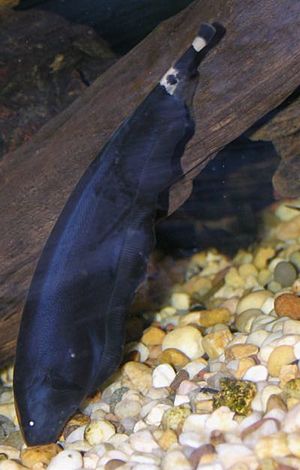South American knifefish facts for kids
Quick facts for kids GymnotiformesTemporal range: Late Jurassic - Recent
|
|
|---|---|
 |
|
| Black ghost knifefish, Apteronotus albifrons | |
| Scientific classification | |
| Kingdom: | |
| Phylum: | |
| Class: | |
| Order: |
Gymnotiformes
|
| Families | |
|
|
The Gymnotiformes are a special group of electric fishes. They are often called Neotropical electric fishes or American knifefishes because they live in freshwater in Central and South America. These fish have amazing body parts that let them create their own electric fields.
Perhaps the most famous fish in this group is the electric eel (Electrophorus electricus). It can make very strong electric shocks, up to 600 volts! It uses these powerful shocks to hunt for food and to protect itself from danger. Other well-known Gymnotiformes that people sometimes keep in aquariums include the black ghost knifefish (Apteronotus albifrons), the glass knifefish (Eigenmannia virescens), and the banded knifefish (Gymnotus carapo).
Contents
What Are Electric Fish?
Electric fish are animals that can produce their own electricity. They do this using special body parts called electric organs. These organs are made of changed muscle cells that create an electric current. Gymnotiformes use their electric abilities for many different things.
How Do They Make Electricity?
The electric organs in Gymnotiformes work like tiny batteries. They have many small cells that can store and release electricity. When these cells all fire at once, they create an electric field around the fish's body. Some fish, like the electric eel, can make very strong electric shocks. Others create much weaker electric fields.
Why Do They Use Electricity?
Gymnotiformes use electricity for several important reasons:
- Navigation: They live in murky (cloudy) waters where it's hard to see. They use their weak electric fields to "see" their surroundings. When the electric field hits an object, it changes, and the fish can sense these changes. This helps them find their way around, even in the dark.
- Communication: They can send electric signals to other fish of their kind. This helps them find mates or warn others about danger. Each species has its own special electric "language."
- Hunting: Strong electric fish, like the electric eel, use powerful shocks to stun or kill their prey. They can zap fish or other small animals, making them easier to catch.
- Defense: The strong electric shocks also help them scare away predators.
Where Do Gymnotiformes Live?
These fascinating fish are found in the freshwaters of Central and South America. They live in rivers, streams, and floodplains. Many prefer slow-moving or still waters with lots of plants or places to hide. Their ability to use electricity helps them survive in these often dark and crowded environments.
Different Kinds of Knifefish
The Gymnotiformes group includes several different families, each with unique features. They are often called "knifefishes" because many of them have long, thin bodies that look a bit like a knife blade. They also have a very long fin on their underside that runs almost the entire length of their body. This fin helps them swim forward and backward with ease.
- Apteronotidae: This family includes the black ghost knifefish. Many of them have a small tail fin and use high-frequency electric signals.
- Gymnotidae: This family includes the banded knifefish and the famous electric eel. They often have a more snake-like body shape.
- Hypopomidae: These are often called "bluntnose knifefishes." They usually have a short, rounded snout.
- Rhamphichthyidae: Known as "sand knifefishes," these fish often bury themselves in the sand.
- Sternopygidae: This family includes the glass knifefish, which has a mostly clear body.
Images for kids
See also
In Spanish: Gymnotiformes para niños



